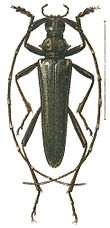| Disteniidae | |
|---|---|

| |
| Distenia gracilis Blessig, 1872 | |
|
Scientific classification
| |
| Domain: | Eukaryota |
| Kingdom: | Animalia |
| Phylum: | Arthropoda |
| Class: | Insecta |
| Order: | Coleoptera |
| Infraorder: | Cucujiformia |
| Superfamily: | Chrysomeloidea |
| Family: |
Disteniidae Thomson, 1860 |
| Tribes | |
| Diversity | |
| ca. 34 genera | |
The Disteniidae are a small family of beetles in the superfamily Chrysomeloidea, traditionally treated as a group within the Cerambycidae (most resembling certain Lepturinae such as the genus Stenocorus, but having long fine antennae and sometimes metallic colours).
Morphology
Adult
The adults have a lepturoid aspect, having like those (except for a small number of cases) a divided stridulatory area. Nevertheless, the head is extremely short, the mandibles are strongly bowed and the anterior coxae are globular. The antennae are long, nearly filiform in most of the genera, and bearing very long setae in the Malagasy genus Nethinius.
Larva
The major differences are in the larval morphology, because they have the prosternal skin attached to the base of the submentum, rather than with the gula such as all other Cerambycidae. For nearly all other aspects, they are very similar to the larvae of Lepturinae.
Distribution
This family, original from Gondwana, includes more than 300 species, widespread in all regions of the Southern Hemisphere, while much less common in the Northern Hemisphere. In particular, only a few species occur in North America and none are present in Europe. In contrast, Madagascar is extremely rich in species, especially of the endemic genus Nethinius.
Biology
The adults have mostly nocturnal behaviour; some species (Nethinius) may be collected beating plants where they live. The fact that several specimens have been collected with mutilated legs and antennae suggests the existence of an aggressive character and of infra-specific fights for females. [1] The larvae are xylophagous and attack wood or roots of broad-leaf trees.
Systematics
The Disteniidae were inserted in "Cerambycides" by Jean Théodore Lacordaire, when the group included all cerambycids known at that time except for Lamiinae and Prioninae. LeConte & Horn (1883) included them in the Lepturinae, even noticing their peculiar primitivism. Gahan [2] considered them as a subfamily suggesting that this group should deserve the elevation to family rank. This statement was formalised by Linsley in 1961, [3] accepted by many subsequent authors [4] [5] [6] [7] [8] [9] [10] [11] [12] [13] and only seldom contested. [14]
The family is composed of 4 tribes: [15] [note 1]
- Cyrtonopini White, 1853
- Disteniini Thomson, 1860
- Dynamostini Lacordaire, 1869
- Heteropalpini Villiers, 1980
Notes
- ^ Subfamilies are not used in the classification of Disteniidae.
References
- ^ VITALI F., 2006 - Contribution à la connaissance des Nethinius malgaches (Coleoptera Disteniidae) - L'Entomologiste 62 (5-6):175-178. PDF [1]
- ^ GAHAN C. J., 1906 - Fauna of British India including Ceylon and Burma. Coleoptera Cerambycidae I - Today & Tomorrow‘s Printers and Publishers, New Delhi, 329 pp. PDF [2]
- ^ LINSLEY E. G., 1961- The Cerambycidae of North America. Part I. Introduction - Univ. Calif. Publ. Entomol. 18:1-97.
- ^ GRESSITT J.L. & RONDON J.A., 1970 - Cerambycids of Laos (Disteniidae, Prioninae, Philinae, Aseminae, Lepturinae, Cerambycinae) - Pae. Insects Monogr. 24: 1-314.
- ^ CHEMSAK, J. A. & LINSLEY.E. G., 1982 - Checklist of the Cerambycidae and Disteniidae of North America,Central America, and the West Indies (Coleoptera). Plexus Publ. Inc., 138 pp.
- ^ NAPP D. S., 1994 - Phylogenetic relationships among the subfamilies of Cerambycidae (Coleoptera, Chrysomeloidea) - Revista Brasileira de Entomologia 28 (2): 265-419.
- ^ MONNÉ, M.A. & GIESBERT E.F., 1995 - Checklist of the Cerambycidae and Disteniidae (Coleoptera) of the Western Hemisphere -Wolfsgarden Books, Burbank, Calif. xiv + 420 pp.
- ^ MARTINS U. R. & GALILEO M. H. M., 2001 - Novos táxons de Disteniidae (Coleoptera) neotropicais - Iheringia, Sér. Zool. (90): 15-20. [3]
- ^ JENIŠ I., 2001 - Long-Horned Beetles Distenidae, Oxypeltidae, Vesperidae, Anoplodermatidae & Cerambycidae I, Vesperidae and Cerambycidae of Europe I, A. Regulus, Zlin, 333 pp. [4]
- ^ BACHMANN A. O. & DI IORIO O. R., 2002 - Types and related specimens of Cerambycidae and Disteniidae (Coleoptera) in the Museo Argentino de Ciencias Naturales "Bernardino Rivadavia", Buenos Aires, [Argentina Rev. Mus. Argentino Cienc. Nat., n.s. 4 (1):55-93 Abstract [5][ permanent dead link]
- ^ VANIN S. A. & IDE S., 2002 - Classificação comentada de Coleoptera - III. Marco sistemático del proyecto Pribes 2002 PDF [6]
- ^ MAKIHARA H. NOERDJITO W. A. & SUGIARTO, 2002 - Longicorn Beetles from Gunung Halimun National Park, West Java, Indonesia from 1997 (Coleoptera, Disteniidae and Cerambycidae) - Bulletin of FFPRI 1 (3) (No. 384): 189-223 PDF [7]
- ^ FUJIWARA J. & HAYASHI M., 2007 - Insect Fauna of Shakunouchi Park in Unnan City, Shimane Prefecture, Part 1 Disteniidae, Cerambycidae and Chrysomalidae (Coleoptera: Chrysomeloidea) - Bulletin of the Hoshizaki Green Foundation 10: 211-223. PDF [8]
- ^ Santos-Silva A. & Hovore F. T.† 2007 - Divisão do gênero Distenia Lepeletier & Audinet-Serville, notas sobre a venação alar em Disteniini, homonímias, sinonímia e redescrições (Coleoptera, Cerambycidae, Disteniinae) - Papéis Avulsos de Zoologia 47 (1): 1-29 PDF [9]
- ^ Švácha, P.; Lawrence, J. (2014). "2.3. Disteniidae J. Thomson, 1861" (PDF). In Leschen, R.A.B.; Beutel, R.G. (eds.). Handbook of Zoology, Arthropoda: Insecta; Coleoptera, Beetles, Volume 3: Morphology and Systematics (Phytophaga). Berlin/Boston: Walter de Gruyter. pp. 60–77. doi: 10.1515/9783110274462.60. ISBN 978-3-11-027446-2.